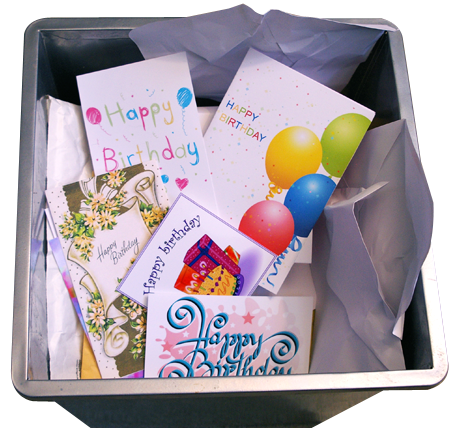
Appraisal of the Carbon Footprint of a Greetings Card
Produced for Dontsendmeacard.com
University of Exeter Centre for Business and Climate Solutions
Sophie O’Callaghan – 13th October 2014

Introduction
Dontsendmeacard.com offers its customers the opportunity to reduce their environmental impact and save money by making donations to charities or individuals instead of sending traditional greetings cards. Dontsendmeacard.com asked the Centre for Business and Climate Solutions to undertake research into the environmental impact of greetings cards, specifically the carbon footprint of a greetings card posted in the UK, to assist the business with its marketing content. This research is presented below.
Statement about CO2e and the nature of carbon footprinting
The carbon footprint figures in this report are expressed in units of CO2e, which stands for ‘carbon dioxide equivalent’. This is the standard unit for measuring carbon footprints; it includes the impact of different greenhouse gases, such as methane and nitrous oxide, as well as carbon dioxide.
The figures and information provided below are based upon research conducted by other individuals and institutions as, due to limited time and resources, it was not possible to produce original research on this topic. It should be noted that these figures are subject to wide variations and are dependent upon a number of factors. The University of Exeter does not make any representation or warranty that information contained in this report is complete or accurate, or that it will not constitute or result in infringement of third-party rights. The University of Exeter cannot accept any responsibility for any use which may be made of any information contained in this report, nor for any reliance which may be placed on the report, which is for information purposes only.
Carbon footprint of a greetings card
After a thorough literature review, the most appropriate estimate that can be found for the embodied carbon or ‘carbon footprint’ in a typical greetings card is 140g CO2e. This figure is based upon a 10g letter, printed upon recycled paper, posted and recycled within the UK1. A typical greetings card usually weighs 30g2 so this estimate errs on the side of caution.
If we were considering a card printed on non-recycled paper, posted within the USA and in turn not recycled, the carbon footprint could be in excess of 200g3.
Some comparisons with the embodied carbon of other products/activities:
5 mile commute – 4.8 tonnes CO2e per year
A London to Glasgow return flight – 500 kg CO2e
Driving London to Glasgow and back in a large four wheel drive – 1100kg CO2e
A necklace made of gold – 400 kg CO2e
A new car – 17 tonnes CO2e
The Iraq War – 250-600 million tonnes CO2e
A cup of white tea – 71g CO2e
The environmental impact of a greetings card derives from the four main parts of its lifecycle:
Paper production
A large part of the impact of a greetings card comes from the manufacture of paper, as this is a very energy intensive process. Recycled paper and card are approximately 50% less energy intensive to produce than virgin material4. Pulp and paper manufacturing is actually one of the largest industry consumers in terms of water and energy usage and total discharges to the environment5. These discharges include emissions of CO2, nitrous oxides and sulphur oxides to air as well as to air (including very harmful pollutants such as AOXs and dioxins), which can cause high COD and BOD and eutrophication6.
The manufacture of paper, where virgin materials are used causes deforestation, which has many negative impacts on the environment, the most severe being loss of natural habitats and loss of carbon sinks, which help to mitigate climate change.
Printing
Printing makes up a relatively small part of the carbon footprint of a greetings card, although the printing industry has significant environmental impacts in terms of greenhouse gas emissions and emissions of volatile organic compounds7.
Postage
For the majority of greetings cards, postage accounts for the highest proportion of the carbon footprint. This impact is mainly derived from transport emissions (vans, trains and planes) and energy consumption in sorting offices.
Decomposition
Sadly, a relatively high proportion of paper (33% in the UK8) is still not recycled. Un-recycled paper is sent to landfill, where it decomposes anaerobically and releases methane, which is a greenhouse gas.
Tree planting
Trees act as a sink for CO2 by fixing carbon during photosynthesis and storing excess carbon as biomass. The net long-term CO2 source/sink dynamics of forests change through time as trees grow, die, and decay. In addition, human influences on forests, such as land management, can further affect CO2 source/sink dynamics of forests through such factors as fossil fuel emissions and harvesting/utilization of biomass.
However, increasing the number of trees might potentially slow the accumulation of atmospheric carbon. On average, one broad leaf tree may absorb in the region of 1 tonne of carbon dioxide during its lifespan, which is approximately 100 years. This is a rough estimate as there are large variations in the uptake of CO2 by trees, depending upon many factors, including species and location as well as the human influences mentioned above9.
A possible future use for waste paper and cards?
Researchers at Imperial College London are developing biofuels from waste paper, using microorganisms to ferment waste paper, which could one day run our cars. They estimate that if all the UK’s discarded wrapping paper and Christmas cards were collected and fermented, they could make enough biofuel to run a double-decker bus to the moon and back more than 20 times10.
www.exeter.ac.uk/climateassist
www.exeter.ac.uk/climateassist
1 How Bad are Bananas? The Carbon Footprint of Everything by Mike Berners-Lee. Profile Books Ltd, 2010.
2 http://www.kgbanswers.co.uk/how-much-does-a-standard-greetings-card-weigh-in-grammes/11120063.
3 The Environmental Impact of Mail: A Baseline, June 2008, ©2008 Pitney Bowes Inc. Available from: http://www.pb.com/docs/US/pdf/Our-Company/Corporate-Responsibility/The-Environmental-Impact-of-Mail-A-Baseline-White-Paper.pdf.
4 UK Paper Making Industries Statistical Facts Sheet, 2006, Utrecht Centre for Energy Research. Available from: http://copernicus.geog.uu.nl/uce-uu/downloads/Icarus/Paper.pdf.
5 Dias, A.C., Arroja, L. and Capela, I., 2007. Life Cycle Assessment of Printing and Writing Paper Produced in Portugal. International Journal of LCA, 12 (7), p521-528.
6 Hewitt, LM., Parrott., and McMaster., M.E., 2007. A Decade of Research on the Environmental Impacts of Pulp and Paper Mill Effluents in Canada: Sources and Characteristics of Bioactive Substances. Journal of Toxicology and Environmental Health, Part B: Critical Reviews, 9 (4), p341-356.
7 UK print industry – report on environmental impact, March 2008, Wiliams Lea. Available from: https://www.williamslea.com/sites/default/files/New%20folder/Environment%20paper%20final%20V2.pdf.
8 Realising the value of recovered paper: an update, Winter 2009/10, WRAP. Available from: http://www.wrap.org.uk/sites/files/wrap/Paper%20Update%20Market%20Situation%20Report%20Winter%202009,%2010.pdf.
9 Nowak, D.J. and Crane, D.E., 2002. Carbon storage and sequestration by urban trees in the USA. Environmental Pollution 116 (3), p381-389.
10 http://www3.imperial.ac.uk/newsandeventspggrp/imperialcollege/newssummary/news_23-12-2011-11-18-53.